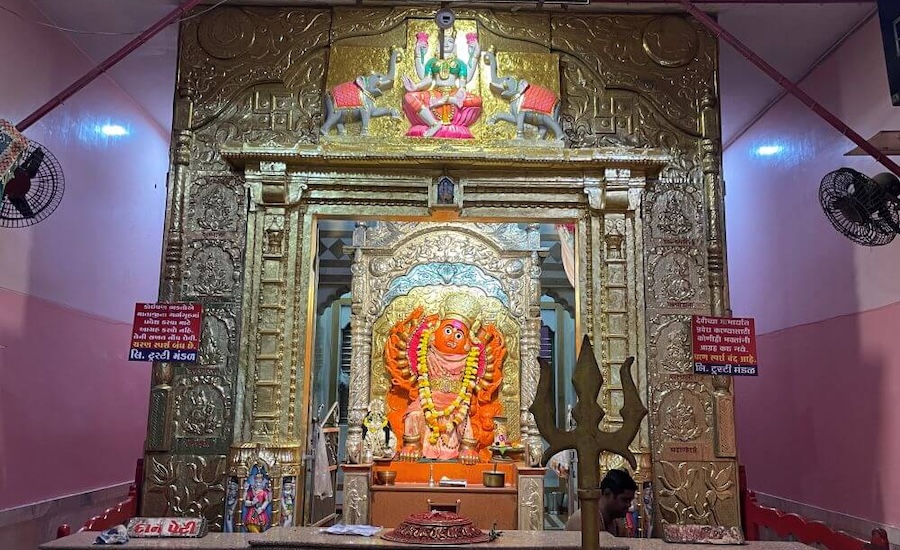
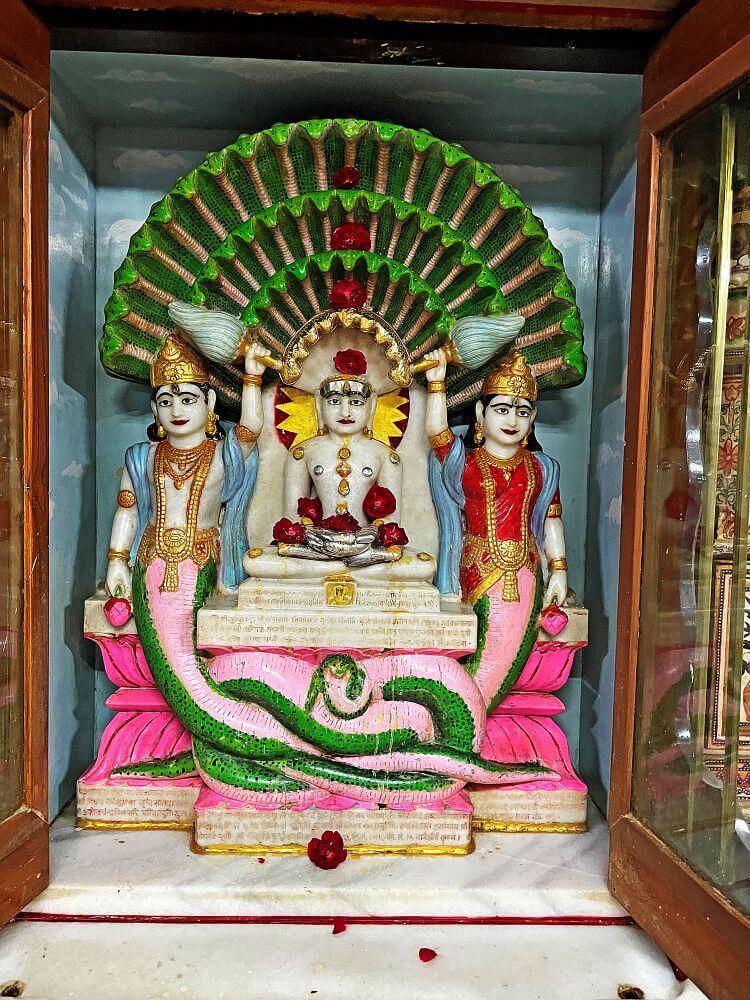 Nestled in the bustling city of Surat, near the historic Rani Talav in Saiyyedpura, lies the revered Chintamani Parshvanath Jain Tirth. This temple, known as a Derasar in Jain tradition, boasts a legacy of over three centuries. Though its exterior appears modest, devoid of domes or spires, the temple holds an exquisite treasure trove of ancient art and craftsmanship within. Renowned for its intricate wood carvings and artistic woodwork, the temple is a prime example of traditional Indian craftsmanship. It also preserves remarkable ancient paintings, created using natural pigments derived exclusively from plants.
Nestled in the bustling city of Surat, near the historic Rani Talav in Saiyyedpura, lies the revered Chintamani Parshvanath Jain Tirth. This temple, known as a Derasar in Jain tradition, boasts a legacy of over three centuries. Though its exterior appears modest, devoid of domes or spires, the temple holds an exquisite treasure trove of ancient art and craftsmanship within. Renowned for its intricate wood carvings and artistic woodwork, the temple is a prime example of traditional Indian craftsmanship. It also preserves remarkable ancient paintings, created using natural pigments derived exclusively from plants.
The temple is dedicated to Lord Parshvanath, the 23rd Tirthankara of Jainism, revered for his peaceful resistance to violence and his role in the spiritual enlightenment of many. According to Jain history, Parshvanath was the second last Tirthankara before Lord Mahavira and was born approximately 250 years earlier in the ancient city of Kashi (present-day Varanasi) around 850 BCE. His birth is celebrated on Paush Krishna Ekadashi. He was born to King Ashvasena and Queen Vamadevi. Parshvanath was married to Prabhavati, the daughter of King Prasenjit of Ayodhya. At the age of thirty, an incident in the royal court where he heard the ‘Rishabhadev Charit’ deeply moved him and led him to renounce worldly life. He embraced asceticism and dedicated himself to a spiritual path. 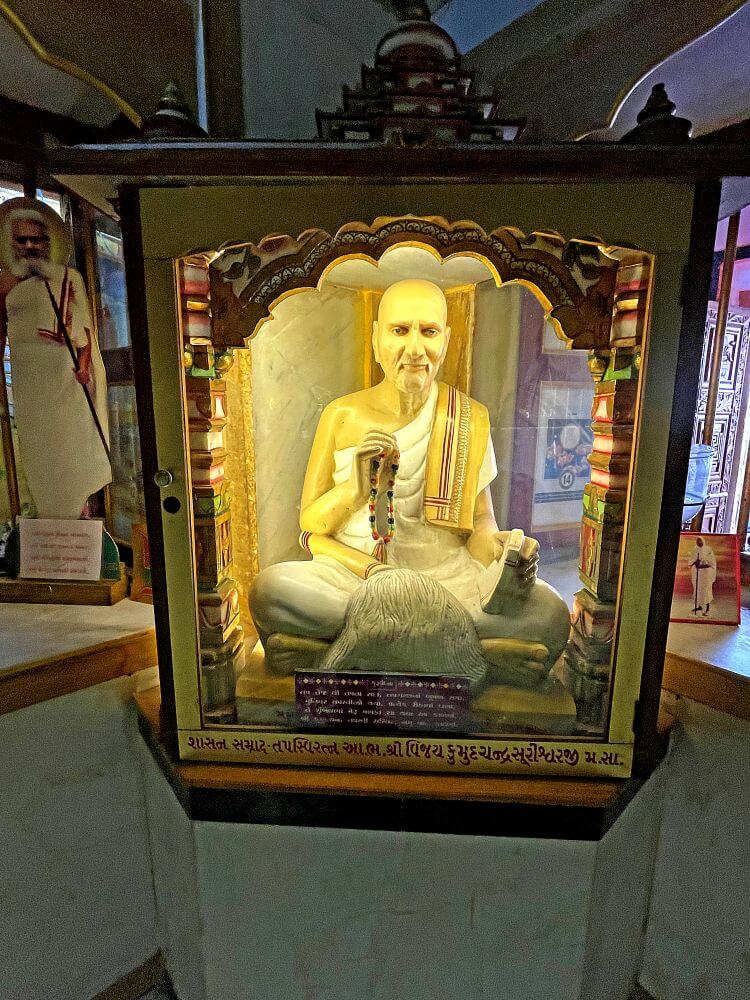 Lord Parshvanath meditated intensely for 83 days on Sammed Shikhar, a sacred mountain now located in Madhuban, Jharkhand. On the 84th day, which fell on Chaitra Krishna Chaturthi, he attained Kevala Jnana (omniscience), reaching the pinnacle of spiritual enlightenment.
Lord Parshvanath meditated intensely for 83 days on Sammed Shikhar, a sacred mountain now located in Madhuban, Jharkhand. On the 84th day, which fell on Chaitra Krishna Chaturthi, he attained Kevala Jnana (omniscience), reaching the pinnacle of spiritual enlightenment.
According to Jain scriptures, there is a fascinating legend surrounding the lives of Lord Parshvanath, the 23rd Tirthankara of Jainism. It is said that Parshvanath underwent nine previous births before achieving his final incarnation as a Tirthankara. In his first birth, he was a Brahmin named Marubhumi. In the second, he was born as an elephant named Vajraghosh. In his third life, he ascended to the heavens as a celestial being, while in the fourth, he became a king named Rashmiveg. His fifth birth was again as a celestial deity and in his sixth, he ruled as Chakravarti Samrat Vajranabhi, an emperor of great renown. In the seventh birth, he returned as a celestial being, followed by his eighth birth as a king named Anand. In the ninth birth, he became Indra, the king of gods. Finally, in his tenth and last incarnation, he was born as Parshvanath and attained enlightenment as a Tirthankara.
A significant event in his spiritual journey took place at Sammed Shikhar, where he was engaged in deep meditation. During this time, an asura (demon), who was his enemy in a past life, attempted to disrupt his penance by unleashing a fierce downpour.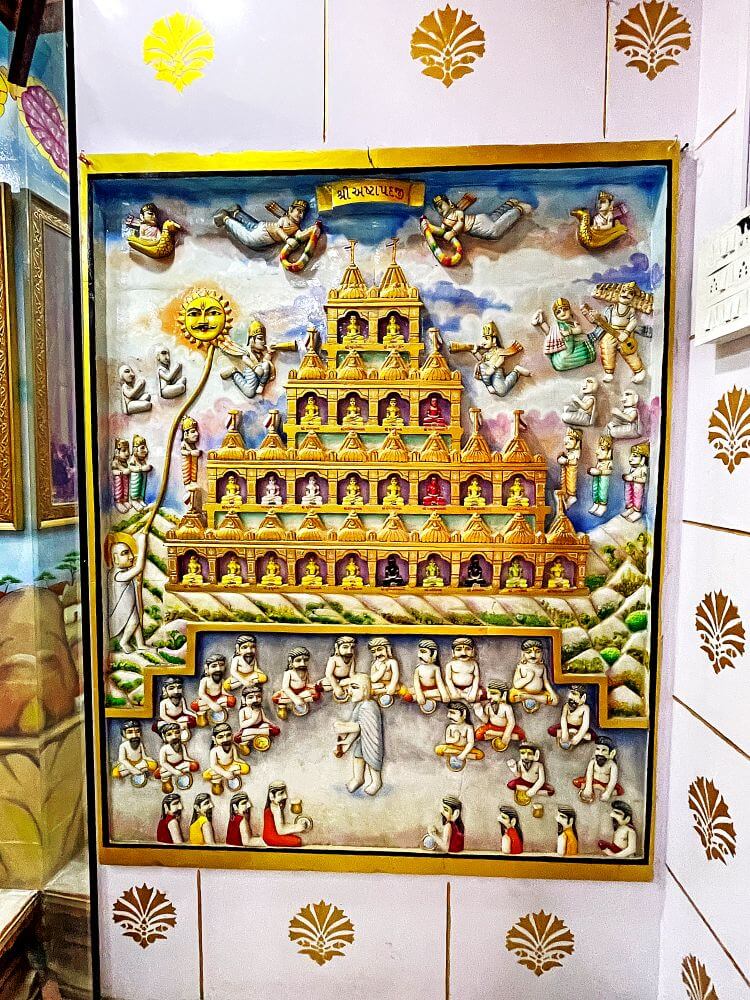 It was then that Nagraj Dharanendra, a serpent deity whom Parshvanath had helped in a previous birth, emerged to protect him. Dharanendra shielded the meditating Parshvanath with his seven serpent hoods. In Jain tradition, each Tirthankara is associated with a unique emblem that distinguishes their idols. For Parshvanath, this emblem is the seven-hooded serpent, reflecting the protection he received during his penance.
It was then that Nagraj Dharanendra, a serpent deity whom Parshvanath had helped in a previous birth, emerged to protect him. Dharanendra shielded the meditating Parshvanath with his seven serpent hoods. In Jain tradition, each Tirthankara is associated with a unique emblem that distinguishes their idols. For Parshvanath, this emblem is the seven-hooded serpent, reflecting the protection he received during his penance.
At the age of 100, Parshvanath attained moksha (liberation) at Sammed Shikhar, now revered as Parasnath Hill. Numerous temples and idols of Parshvanath can be found across India, each serving as a testament to his spiritual legacy. Among these is the Chintamani Parshvanath Jain Tirth, which continues to be a sacred and venerated site for Jain devotees.
The history of this temple traces back to a turbulent period in the late 17th century. Following Chhatrapati Shivaji Maharaj’s raids on Surat in 1664 and 1670, the city’s thriving trade began to decline. During Chhatrapati Sambhaji Maharaj’s reign after 1680, the Maratha forces frequently attacked Mughal territories in Gujarat, compelling Emperor Aurangzeb to focus his attention on the south. After 1690, the British East India Company shifted its interests from Surat to Mumbai, further diminishing Surat’s prominence.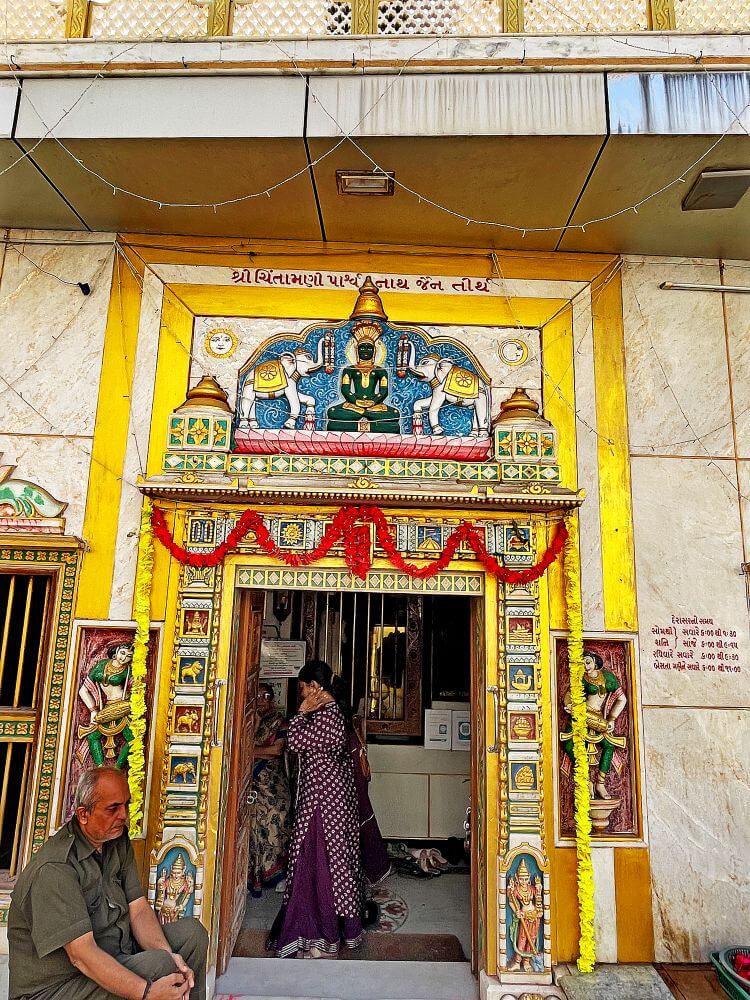 Amid this chaos, in 1699, the temple dedicated to Lord Parshvanath was established in Saiyyadpura, Surat.
Amid this chaos, in 1699, the temple dedicated to Lord Parshvanath was established in Saiyyadpura, Surat.
From the outside, the temple resembles a simple mansion, a stark contrast to its intricate interior. It features two wooden gateways, with the main entrance adorned by marble pillars intricately carved with various Jain symbols. At the base of these pillars are sculptures of welcoming attendants (Dwarsevikas) and the walls on either side of the entrance are decorated with sculptures of celestial maidens (Sursundaris). Above the entrance, a magnificent carving of Lord Parshvanath in a meditative Padmasana posture is positioned. Over his head, Nagraj Dharanendra is depicted spreading his protective hood, symbolising divine shelter. Flanking this central carving are sculptures of elephants (Gajarajas) holding floral garlands in their trunks, adding to the visual splendour. The entrance also features a marble threshold (Mandarak), which has worn down over the centuries, subtly underscoring the temple’s antiquity and historical significance.
As we enter through the main gateway, we are greeted by a small porch that leads to a narrow corridor guiding visitors towards the Rangamandap (assembly hall) entrance. This corridor is adorned with vibrant murals depicting significant events from the life of Lord Parshvanath. These include moments such as Parshvanath in the royal palace, his act of saving a serpent from burning logs,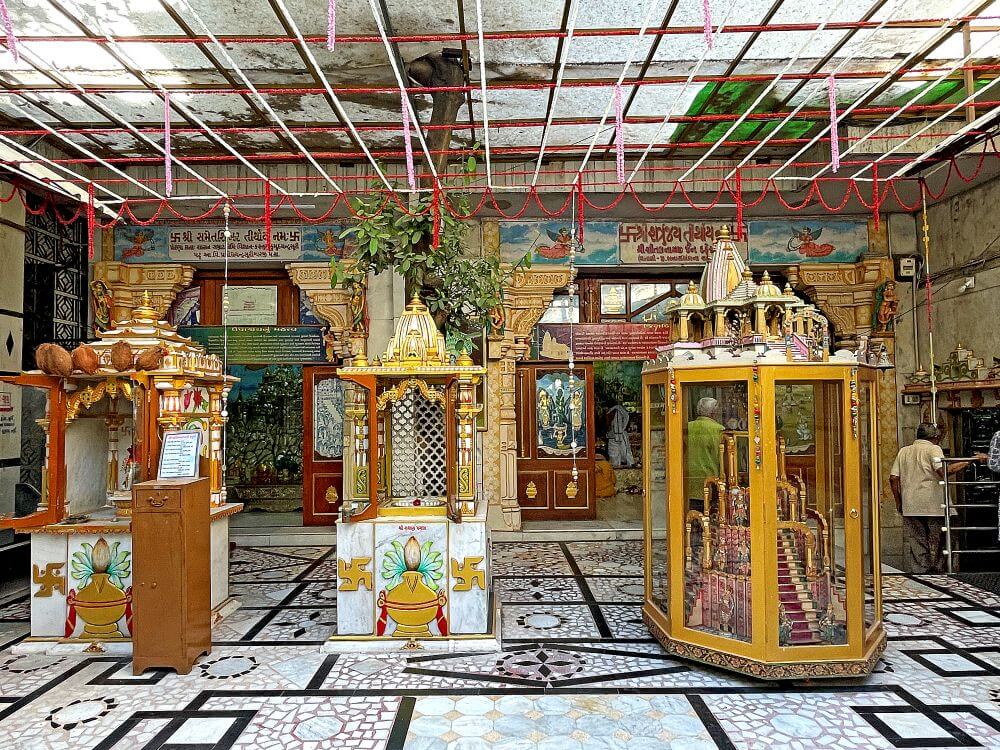 the challenges posed by his past-life enemy Meghmali (formerly Kamath) during his meditation, the establishment of his spiritual order and his return in a child’s guise to meet his mother.
the challenges posed by his past-life enemy Meghmali (formerly Kamath) during his meditation, the establishment of his spiritual order and his return in a child’s guise to meet his mother.
The pillars of the temple feature intricately carved idols of Suvarna Parshvanath (Golden Parshvanath) and Nageshwar Parshvanath, along with a stunning sculpture of Padmavati Devi seated on a serpent throne (*Sarpa Asana*). Rajarajeshwari Padmavati Devi is revered as the protective deity (Shasan Devi) of Parshvanath. The exquisite murals and carvings showcase the fine artistry of ancient sculptures and paintings, with the vivid colours of the murals remarkably intact to this day. Near the entrance to the Rangamandap, within a delicately carved alcove (Makhar), resides an idol of Goddess Mahalaxmi.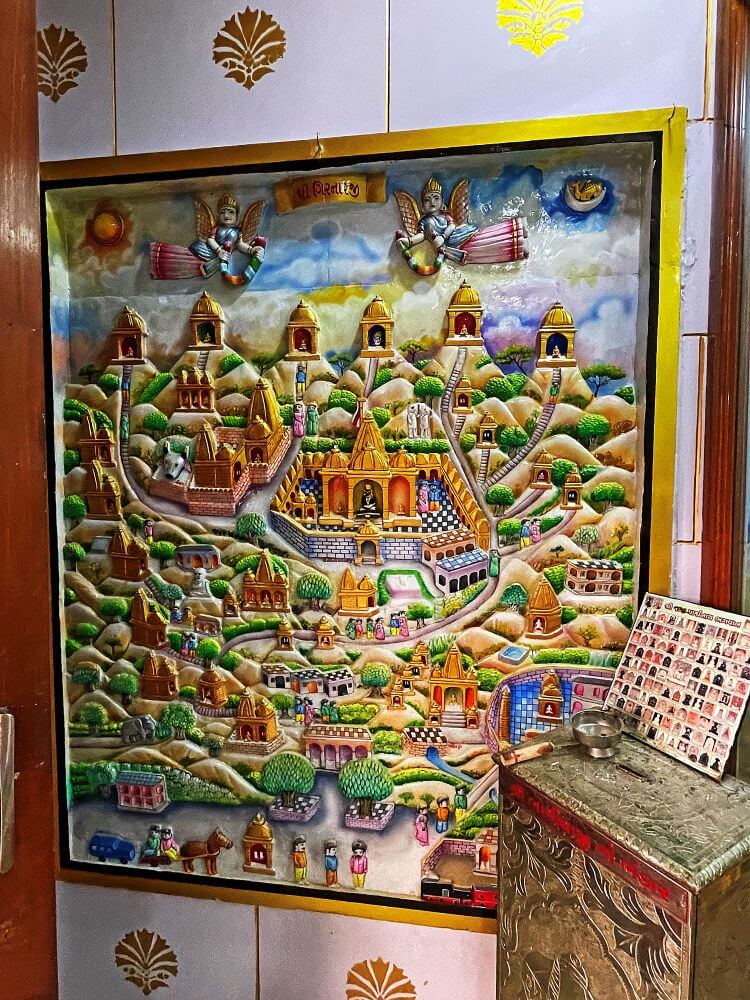
The robust wooden and gilded doors of the Rangamandap are equally spectacular, featuring intricate carvings of Lord Parshvanath, Goddess Padmavati and Gajaraja (elephants). Flanking the doorway are tall glass cabinets displaying small marble idols of Tirthankars (spiritual teachers of Jainism) in various forms, each a testament to the devotional artistry of the temple. These artistic details create an awe-inspiring introduction to the sanctum’s spiritual journey.
Upon entering, the eyes are immediately drawn to the exquisitely adorned Rangamandap (assembly hall), featuring numerous intricately carved wooden pillars, embellished with hanging glass lamps and chandeliers. Several pillars are adorned with miniature paintings depicting men and women engaged in music and dance. Similarly, the walls of the Rangamandap are embellished with mural panels and miniature paintings of this style. The carvings on certain pillars are particularly remarkable, featuring idols of Tirthankaras. These pillars, along with their carvings and paintings, are over three centuries old and have now been encased in glass for preservation.
One notable artwork in the Rangamandap is the portrait of Raja Kumarapala and Acharya Hemchandra, an invaluable historical legacy. Kumarapala (reigned 1143–1172 CE), a king from the Solanki dynasty of Gujarat, ruled from Anhilwad (modern-day Patan in Gujarat). Historical accounts suggest he was the son of a maidservant of Solanki King Bhima I.  With the assistance of his brother-in-law and Jain followers, he ascended the throne. Though originally a follower of Shaivism, Kumarapala converted to Jainism under the guidance of the great Jain scholar Acharya Hemchandra.
With the assistance of his brother-in-law and Jain followers, he ascended the throne. Though originally a follower of Shaivism, Kumarapala converted to Jainism under the guidance of the great Jain scholar Acharya Hemchandra.
Acharya Hemchandra, a renowned polymath and mathematician, authored significant works such as ‘Siddhahemashabdanusasanam’, ‘Kavyamananda’, ‘Anekartha Kosa’ and ‘Unadisutra Vritti’. His influence on Kumarapala was profound. It is said that Kumarapala could not bear the grief of Hemchandra’s death and passed away six months later. During his reign, Kumarapala banned animal slaughter and gambling and was responsible for the construction of many Hindu and Jain temples. The portrait of these two illustrious figures is a rare artifact preserved in a large glass cabinet in the Rangamandap.
At the far end of the Rangamandap lies the Garbha Griha (sanctum sanctorum), where Lord Parshvanath’s idol is enshrined on a tall, golden pedestal. The outer walls of the sanctum are also adorned with intricate carvings. On all three sides of the outer walls are niches (Devakoshthakas) housing idols of Tirthankaras and Acharyas. The carvings and sculptures in these niches are of exceptional detail and beauty, protected under glass casings to ensure their preservation.
Adjacent to the Rangamandap, there is a spacious courtyard. Within this courtyard, a large glass-enclosed room houses grand replicas of Shatrunjaya Mahatirth and Shikharji Mahatirth, two of the holiest pilgrimage sites in Jainism. According to Jain tradition, Shikharji (located in Jharkhand) is where 20 of the 24 Tirthankaras attained moksha (liberation). Shatrunjaya Mahatirth, originally known as Pundarikgiri, is near the city of Palitana in Bhavnagar district. This site boasts 865 Jain temples and is believed to be where the first Tirthankara, Rishabhanatha, delivered a sermon and where his grandson, Pundarik Swami, attained moksha.
The courtyard also features three smaller Devakulikas (small shrines) and marble seating areas for devotees to rest. These serene additions enhance the spiritual atmosphere of the temple premises.
Devotees can visit the temple to seek darshan (a divine glimpse) of Lord Parshvanath from Monday to Saturday, between 6:00 AM and 1:30 PM and again in the evening from 6:00 PM to 9:30 PM. On Sundays, darshan is available from 6:00 AM to 9:30 PM. On Besta, the Jain New Year’s Day, darshan timings extend from 6:00 AM to 11:00 PM, allowing devotees to spend extended hours in prayer and reflection.
